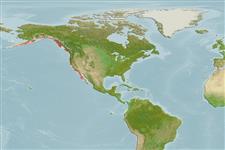Environment: milieu / climate zone / depth range / distribution range
Ecologia
marino demersale; distribuzione batimetrica 0 - 15 m (Ref. 2850). Subtropical
Northeast Pacific: Sitka, Alaska to southern British Columbia, Canada and to Baja California, Mexico.
Size / Peso / Age
Maturity: Lm ? range ? - ? cm
Max length : 13.0 cm TL maschio/sesso non determinato; (Ref. 2850)
Short description
Chiavi di identificazione | Morfologia | Morfometria
Spine dorsali (totale) : 0; Raggi dorsali molli (totale) : 28 - 30; Spine anali: 0; Raggi anali molli: 22 - 24. Dorsal fin with 2 parts, the first short, low and rounded, the second with longer rays that almost reach the caudal. Caudal narrow with rounded end. Ventral lobe of pectorals with thick exserted longer rays.
Occurs from intertidal areas to 15 m depth, but usually not in tide pools (Ref. 2850).
Life cycle and mating behavior
Maturità | Riproduzione | Deposizione | Uova | Fecundity | Larve
Eschmeyer, W.N., E.S. Herald and H. Hammann, 1983. A field guide to Pacific coast fishes of North America. Boston (MA, USA): Houghton Mifflin Company. xii+336 p. (Ref. 2850)
IUCN Red List Status (Ref. 130435: Version 2024-1)
Threat to humans
Harmless
Human uses
Pesca: di nessun interesse
Strumenti
Special reports
Download XML
Fonti Internet
Estimates based on models
Preferred temperature (Ref.
123201): 8.7 - 17.9, mean 10.7 °C (based on 200 cells).
Phylogenetic diversity index (Ref.
82804): PD
50 = 0.5000 [Uniqueness, from 0.5 = low to 2.0 = high].
Bayesian length-weight: a=0.00525 (0.00237 - 0.01161), b=3.15 (2.96 - 3.34), in cm total length, based on LWR estimates for this (Sub)family-body shape (Ref.
93245).
Trophic level (Ref.
69278): 3.4 ±0.6 se; based on size and trophs of closest relatives
Resilienza (Ref.
120179): Alto, tempo minimo di raddoppiamento della popolazione meno di 15 mesi (Preliminary K or Fecundity.).
Fishing Vulnerability (Ref.
59153): Low vulnerability (10 of 100).
